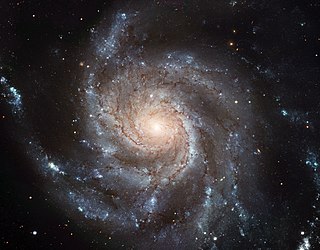
The Pinwheel Galaxy is a face-on spiral galaxy 21 million light-years away from Earth in the constellation Ursa Major. It was discovered by Pierre Méchain in 1781 and was communicated that year to Charles Messier, who verified its position for inclusion in the Messier Catalogue as one of its final entries.

The Black Eye Galaxy is a relatively isolated spiral galaxy 17 million light-years away in the mildly northern constellation of Coma Berenices. It was discovered by Edward Pigott in March 1779, and independently by Johann Elert Bode in April of the same year, as well as by Charles Messier the next year. A dark band of absorbing dust partially in front of its bright nucleus gave rise to its nicknames of the "Black Eye", "Evil Eye", or "Sleeping Beauty" galaxy. M64 is well known among amateur astronomers due to its form in small telescopes and visibility across inhabited latitudes.
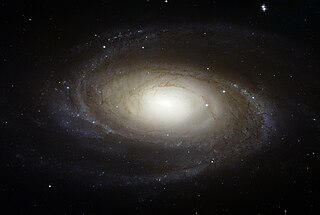
Messier 81 (also known as NGC 3031 or Bode's Galaxy) is a grand design spiral galaxy about 12 million light-years away in the constellation Ursa Major. It has a D25 isophotal diameter of 29.44 kiloparsecs (96,000 light-years). Because of its relative proximity to the Milky Way galaxy, large size, and active galactic nucleus (which harbors a 70 million M☉ supermassive black hole), Messier 81 has been studied extensively by professional astronomers. The galaxy's large size and relatively high brightness also makes it a popular target for amateur astronomers. In late February 2022, astronomers reported that M81 may be the source of FRB 20200120E, a repeating fast radio burst.

Messier 74 is a large spiral galaxy in the equatorial constellation Pisces. It is about 32 million light-years away from Earth. The galaxy contains two clearly defined spiral arms and is therefore used as an archetypal example of a grand design spiral galaxy. The galaxy's low surface brightness makes it the most difficult Messier object for amateur astronomers to observe. Its relatively large angular size and the galaxy's face-on orientation make it an ideal object for professional astronomers who want to study spiral arm structure and spiral density waves. It is estimated that M74 hosts about 100 billion stars.
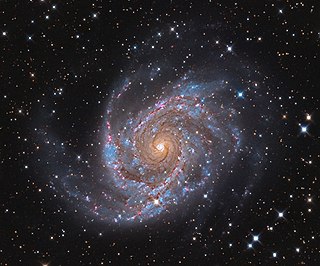
NGC 2997 is a face-on unbarred spiral galaxy about 40 million light-years away in the faint southern constellation of Antlia. It was discovered March 4, 1793 by German-born astronomer William Herschel. J. L. E. Dreyer described it as, "a remarkable object, very faint, very large, very gradually then very suddenly bright middle and 4 arcsec nucleus. This is the brightest galaxy of the NGC 2997 group of galaxies, and was featured on the cover of the first edition of Galactic Dynamics by James Binney and Scott Tremaine.

NGC 2207 and IC 2163 are a pair of colliding spiral galaxies about 80 million light-years away in the constellation Canis Major. Both galaxies were discovered by John Herschel in 1835.

NGC 1566, sometimes known as the Spanish Dancer, is an intermediate spiral galaxy in the constellation Dorado, positioned about 3.5° to the south of the star Gamma Doradus. It was discovered on May 28, 1826 by Scottish astronomer James Dunlop. At 10th magnitude, it requires a telescope to view. The distance to this galaxy remains elusive, with measurements ranging from 6 Mpc up to 21 Mpc.

NGC 4639 is a barred spiral galaxy located in the equatorial constellation of Virgo. It was discovered by German-born astronomer William Herschel on April 12, 1784. John L. E. Dreyer described it as "pretty bright, small, extended, mottled but not resolved, 12th magnitude star 1 arcmin to southeast". This is a relatively nearby galaxy, lying approximately 72 million light-years away from the Milky Way. It is a companion to NGC 4654, and the two appear to have interacted roughly 500 million years ago. NGC 4639 is a member of the Virgo Cluster.
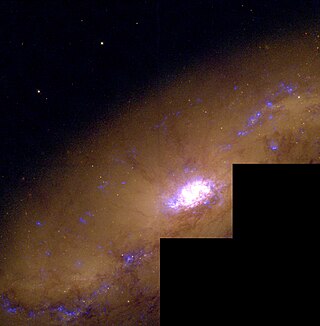
NGC 1808 is a barred spiral galaxy located in the southern constellation of Columba, about two degrees to the south and east of Gamma Caeli. It was discovered by Scottish astronomer James Dunlop, who described it as a "faint nebula". The galaxy is a member of the NGC 1808 group, which is part of the larger Dorado Group.
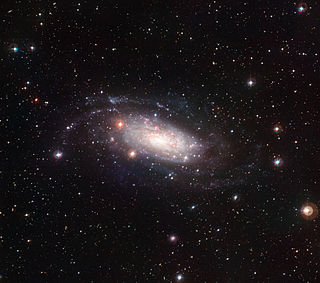
NGC 3621 is a field spiral galaxy about 22 Mly (6.7 Mpc) away in the equatorial constellation of Hydra. It is comparatively bright and can be well seen in moderate-sized telescopes. The galaxy is around 93,000 ly (29,000 pc) across and is inclined at an angle of 25° from being viewed edge on. It shines with a luminosity equal to 13 billion times that of the Sun. The morphological classification is SA(s)d, which indicates this is an ordinary spiral with loosely wound arms. There is no evidence for a bulge. Although it appears to be isolated, NGC 3621 belongs to the Leo spur.

NGC 178 is a Magellanic spiral galaxy in the constellation of Cetus. The compiler of the New General Catalogue, John Louis Emil Dreyer noted that NGC 178 was "faint, small, much extended 0°, brighter middle". It was discovered on November 3, 1885 by Ormond Stone.

NGC 4699 is an intermediate spiral galaxy located in the constellation Virgo. It is located at a distance of circa 65 million light years from Earth, which, given its apparent dimensions, means that NGC 4699 is about 85,000 light years across. It was discovered by William Herschel in 1786. It is a member of the NGC 4699 Group of galaxies, which is a member of the Virgo II Groups, a series of galaxies and galaxy clusters strung out from the southern edge of the Virgo Supercluster.
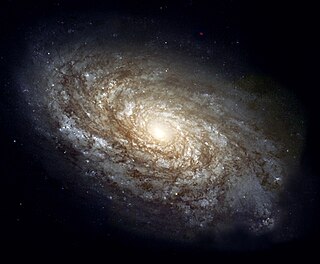
The Coma I Group is a group of galaxies located about 14.5 Mpc (47.3 Mly) away in the constellation Coma Berenices. The brightest member of the group is NGC 4725. The Coma I Group is rich in spiral galaxies while containing few elliptical and lenticular galaxies. Coma I lies in the foreground of the more distant Coma and Leo clusters and is located within the Virgo Supercluster.

NGC 2336 is a Barred spiral galaxy located in the constellation Camelopardalis. It is located at a distance of circa 100 million light years from Earth, which, given its apparent dimensions, means that NGC 2336 is about 200,000 light years across. It was discovered by Wilhelm Tempel in 1876.

NGC 2835 is an intermediate spiral galaxy located in the constellation Hydra. It is located at a distance of circa 35 million light years from Earth, which, given its apparent dimensions, means that NGC 2835 is about 65,000 light years across. It was discovered by Wilhelm Tempel on April 13, 1884. NGC 2835 is located only 18.5 degrees from the galactic plane.

NGC 3367 is a barred spiral galaxy located in the constellation Leo. It is located at a distance of about 120 million light years from Earth, which, given its apparent dimensions, means that NGC 3367 is about 85,000 light years across. It was discovered by William Herschel on March 19, 1784.

IC 5201 is a barred spiral galaxy located in the constellation Grus. It is located at a distance of about 35 million light years from Earth, which, given its apparent dimensions, means that IC 5201 is about 90,000 light years across. It was discovered by Joseph Lunt in 1900.

NGC 691 is an unbarred spiral galaxy located in the constellation Aries. It is located at a distance of circa 120 million light years from Earth, which, given its apparent dimensions, means that NGC 691 is about 130,000 light years across. It was discovered by William Herschel on November 13, 1786.

NGC 539 is a barred spiral galaxy in the constellation of Cetus south. It is estimated to be 429 million light years from the Milky Way and has a diameter of approximately 200,000 ly.

NGC 2906 is a spiral galaxy located in the constellation Leo. It is located at a distance of circa 120 million light years from Earth, which, given its apparent dimensions, means that NGC 2906 is about 75,000 light years across. It was discovered by William Herschel on December 28, 1785.




















